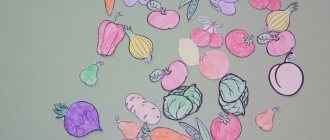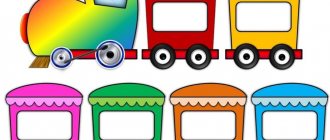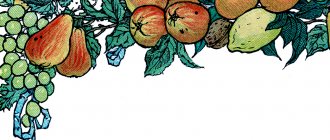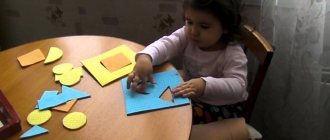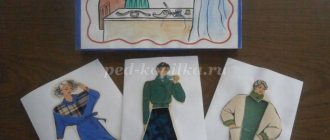Didactic game “What grows in the garden?”
Tatyana Alshevskaya
Didactic game “What grows in the garden?”
Material: cards with images of vegetables, fruits, mushrooms, berries, items of non-plant origin (toys, clothes, etc.)
;
board on which stripes are glued - beds .
Option 1: “What are we talking about?”
. The teacher asks riddles, and the children find a card with the desired answer.
1) Offer children cards with vegetables (fruits, mushrooms, berries, among which there will be one extra item (for example, not a vegetable)
.
2) Offer children cards with objects of the same color (shapes, among which there will be an object of a different color (shapes)
. Ask him to explain why he is superfluous.
3) From all items, remove the one that does not grow in its region (for example, pineapple)
.
4) Remove from all items the one that is not a plant .
Option 3: “Where does it grow ?”
.
1) Select only those items that grow in the garden bed .
2) Select only those items that grow in our region .
Option 4: “Find out by description”
. The teacher describes the object (vegetable, fruit, mushroom, berry; children use the description to find the object.
Expanding children’s knowledge about the world around them “What grows in the garden” Goal: expanding children’s knowledge about the world around them, about nature. Educational objectives: To consolidate children's knowledge about autumn signs.
Project “What a miracle vegetable garden is growing in the window” How vegetables would not be born without our help. As soon as spring has arrived, we plant seeds. What a garden! People are surprised. The sun warmed the earth. Didactic game “What is good and what is bad for teeth?” Objectives: to introduce children to the concepts of “health” and “disease”, “healthy” and “harmful” foods; develop the ability to take care of your health. Didactic game “What is good and what is bad for health” Purpose of the game: to introduce children to the rules of personal hygiene and a correct, careful attitude towards their health; find out what is useful and what is not. Didactic game “Who lives where, what grows where?” Dear colleagues! Good day everyone! In my work on environmental education of preschoolers, I attach great importance. Didactic game “Harvest in the garden - collect and plant” Didactic game “Harvest in the garden - collect and plant” The game is designed for children of the younger group (from 2 to 4 years old) Purpose: to develop cognitive skills.
Summary of educational activities for the younger group “What grows in the garden bed” St. Petersburg State Budgetary Institution “CHILDREN'S SANATORIUM “KOSTYOR” Summary of educational activities for children of the 5th group “What grows in the garden bed” Educator: T. A. Novozhilova.
Mini-museum “What grows in the garden bed” As part of the implementation of the long-term project “Myselskie Residents”, on November 19, a mini-museum “What grows in the garden bed” was opened in the kindergarten.
Presentation “What grows in our garden” Presentation “What grows in our garden”. The presentation is presented in the form of a game of Masha and the Bear. Once upon a time there lived Masha and the Bear in a house, but...
Lesson “What grows in the garden” (middle group) Purpose: to systematize and generalize children’s ideas about vegetables that differ from each other in appearance. Integration of educational.
Source
Didactic game for the younger group “What grows where?”
ZOYA KHANINA
Didactic game for the younger group “What grows where?”
Didactic game for the younger group on the topic : “What grows ?
" Goal: expand and clarify ideas
children about vegetables and fruits, develop memory and speech.
- consider vegetables and fruits;
-explain how all this can be called in one word or
-pay attention to the following signs
vegetables and fruits: color, shape, taste;
-tell and show children where vegetables and fruits grow ;
- invite children to tell from their own experience what can be cooked from vegetables and fruits;
-learn appropriate riddles with the children: for example: They hang in clusters
And they look at the sun,
Color like a traffic light
Red Yellow. (tomato)
.
Material: model of a tree, model of a vegetable garden, drawn and cut out vegetables and fruits.
Didactic game "Cat's House". “Cat’s Garden” (for children of the first junior group) The purpose of the game: to give children a basic understanding of the vegetable garden and orchard, about what grows in them. Objectives: develop the ability to distinguish.
Homework for children of the secondary speech therapy group on the lexical topic “Autumn Gifts” Topic: Autumn Gifts Paste (draw) pictures depicting vegetables and fruits. The child must be able to name: • Fruits • Vegetables • In one word:.
Source
Didactic game “What grows on a tree and what grows in a garden bed?”
Yulia Sycheva
Didactic game “What grows on a tree and what grows in a garden bed?”
Didactic game “What grows on a tree and what grows in a garden bed ?”
Goal: Teaching coherent speech, intelligence, thinking, memory, and the ability to concentrate.
Objective: To teach how to identify the shapes of an object and their purpose. Learn to classify vegetables and fruits.
Equipment: Felt tree , garden bed (basket filled with black cloth, soft felt toys (fruits and vegetables)
.
Progress of the game: The teacher places toys on the table (vegetables and fruits, a game aid - a tree and a game aid " bed "
(basket with earth
(made of black fabric)
:
The teacher shows the children a toy; they must name what it is? Describe what they see growing on a tree or bed .
With the help of such a game, children form a sequence of events occurring in nature.
Enrichment of vocabulary.
The child's speech develops.
Taking into account the heavy workload of parents with daily household chores and the fatigue accumulated at the end of the day, we offer the following games and play exercises to consolidate various speech skills and develop fine motor skills.
1. Game exercises to develop fine motor skills of the hands.
You spend most of your time in the kitchen. You are busy preparing dinner. The baby is spinning around you. Invite him to sort out peas, rice, buckwheat or millet. Thus, he will provide you with all possible assistance and train his fingers.
Give your child counting sticks or matches (with the heads cut off)
. Let him lay out simple geometric shapes, objects or patterns from them. And circles, ovals, and trapezoids cut out of paper will complement the images.
2. Games to enrich a child’s vocabulary.
• “Let’s look for words in the kitchen.”
What words can be “taken out” from borscht? Vinaigrette? Kitchen cabinet? Plates? etc.
“Let's remember the “tasty” words and treat each other. The child names a “delicious” word and “puts it” on your palm, then you give it to him, and so on until you “eat” everything. You can play with “sweet”, “sour”, “salty”, “bitter” words.
3. Game exercises to develop the grammatical structure of speech.
“Juice from apples. (apple, from pears. (pear, from plums. (plum, from carrots, lemon, orange, etc. Did you manage? And now it’s the other way around: what is orange juice made from? Etc.
“How a miracle tree grows at our gates” Once upon a time, along with the blanks for tea houses, I received blanks for two Christmas trees and a tree for jewelry. Having seen enough different ideas on MAAM. Didactic game for children 5–7 years old “What grows where?” Did. task: to clarify children’s knowledge of the names and places where plants grow; develop attention, intelligence, memory. Materials:. Didactic game “Who lives where, what grows where?” Dear colleagues! Good day everyone! In my work on environmental education of preschoolers, I attach great importance. Didactic game for environmental education of senior preschool children “What grows in the garden?” Purpose of the game: Continue to form children's ideas about vegetable crops, the rules of their life support and benefits for humans. The game is possible.
Source
Didactic games on ecology for preschoolers. Middle - senior group
Didactic games on ecology
1. “Birds, fish, animals” Purpose: To train children in the ability to name an object of a certain group of objects. Game actions: The presenter throws the ball to the child and says the word “birds”. The child who catches the ball must select a specific concept, for example, “sparrow,” and throw the ball back. The next child must name the bird, but not repeat himself. The game is played in a similar way with the words “animals” and “fish”. 2. “Guess what’s in your hand” Goal: Distinguish vegetables, fruits and berries by touch. Game actions: Children stand in a circle, holding their hands behind their backs. The teacher places models of vegetables, berries and fruits in the children’s hands. Children must guess. The teacher shows, for example, a pear and asks to determine who has the same object (fruit, vegetable, berry). 3. “Flies, swims, runs” Purpose: Depict the method of movement of an object. Game actions: The presenter names or shows the children an object of living nature and invites the children to depict the method of movement of this object. For example, when hearing the word “bear,” children begin to imitate walking like a bear; “magpie” children begin to wave their arms and so on. 4. Game “Good - Bad” Purpose: To improve children’s knowledge about the phenomena of living and inanimate nature, animals and plants. Game actions: The teacher or teacher offers children different situations, and the children make conclusions, for example: “Is a clear sunny day in the fall good or bad?”, “All the wolves have disappeared in the forest - is this good or bad?”, “It rains every day - is it bad or good?”, “A snowy winter - is it good or bad?”, “All the trees are green - is it good or bad?”, “A lot of flowers in our garden - is it bad or good?”, “My grandmother in the village has is a cow good or bad?”, “All the birds on earth have disappeared - is that good or bad?” and so on. 5. “Who is after whom?” Goal: Show children that in nature everything is connected. Continue to instill in children a caring attitude towards all animals. Game actions: The teacher invites the called child to connect with a ribbon all the animals that hunt each other. Other children also help find the correct pictures of animals. You can suggest starting the game with a plant, a frog or a mosquito. 6. “What's extra” Usually this game is used to develop thinking, but it can also be used to develop visual and auditory memory, depending on how the material is presented - visually or auditorily. Goal: development of visual and auditory memory and thinking, activation of children's vocabulary. Equipment: cards with a set of 4 words (pictures): three words - one generalizing concept, one word - another generalizing concept. Progress of the game: The child is asked to listen (watch) and remember a number of words (pictures). The presentation time for each picture is 1 second. After presentation, the pictures are covered or removed. Then he is asked to repeat these words (name the pictures). Next, the child is asked the question: “What word (picture) do you think is superfluous? Why?". Then the child is asked to remember and list the remaining three words (pictures). After this, the child is once again asked to list the entire series of words (pictures) in the order in which they were presented. The complexity of the game occurs due to an increase in the number of memorized words or pictures, as well as through a more subtle differentiation of general concepts (for example, tableware - tableware, kitchen, tea). Approximate list of equipment for the game Domestic - wild birds Chicken, goose, turkey ram Duck, rooster, peacock horse Chicken, duckling, gosling pig Birds - animals Ostrich, penguin, stork dolphin Dolphin, walrus, octopus penguin 7. “The Fourth Wheel” Purpose: . develop in children a cognitive interest in the life of feathered friends, teach them to understand the figurative meaning of riddles. 1. hare, hedgehog, fox, bumblebee; 2. wagtail, spider, starling, magpie; 3. butterfly, dragonfly, raccoon, bee; 4. grasshopper, ladybug, sparrow, chafer; 5. bee, dragonfly, raccoon, bee; 6. grasshopper, ladybug, sparrow, mosquito; 7. cockroach, fly, bee, cockchafer; 8. dragonfly, grasshopper, bee, ladybug; 9. frog, mosquito, beetle, butterfly; 10. dragonfly, moth, bumblebee, sparrow. 8. “Lay out a bird (animal, object) from geometric shapes” Goal: continue to teach children to lay out images of animals, objects, natural phenomena, etc. d., using geometric shapes; develop creative imagination, evoke a desire to fantasize. Equipment: cards, a set of geometric shapes. The teacher offers to play a game during which children come up with their own objects and images, using previously acquired knowledge and skills. 9. Find by description Purpose: to consolidate the idea of the features of the appearance of plants, to teach children to independently describe a plant. Game task: find a plant based on the listed characteristics. Material: cards with pictures of plants. Progress of the game: The presenter names the characteristic features of a particular plant without naming it. Children look for his image among the cards. The winner is the one who quickly and correctly finds or names the answer. 10. Lotto “What grows where?” Goal: to strengthen children’s ability to classify plants according to their place of growth; develop mindfulness. Game task: fill the playing field. Materials: playing fields - meadow, forest, pond, swamp. Cards depicting plants growing in these ecosystems. Progress of the game: Children choose playing fields. The presenter shuffles the cards and, taking out one at a time, names the plant. Children playing take away those cards that correspond to their playing field. The one who fills the playing field faster wins.
We recommend watching:
Ecological holiday. Earth Day. Scenario for children of the senior group Didactic games on ecology for children of the preparatory group of kindergarten Ecological game: “What? Where? When?" for children 5-7 years old Game activities on ecology in kindergarten. Junior group
Similar articles:
Ecological games for schoolchildren
Ecological holiday for schoolchildren. Scenario 7-9 grade
Summary of the didactic game “What grows in the Bunny’s garden” for young children
Elena Chuvilina
Summary of the didactic game “What grows in the Bunny’s garden” for young children
Didactic game “What grows in the Bunny’s garden.” The world.
Didactic task. Teach children to distinguish vegetables by taste and appearance.
Game task. Guess what vegetables the bunny put in the soup.
Game rule. Take out vegetables and identify them by taste and appearance.
Progress of the game
The teacher tells the children that the Bunny has come to us. But the bunny is sad. Do you want to know what happened to him? The teacher shows the bunny and tells the children: “The bunny grew a good harvest of vegetables in his garden: potatoes, carrots, cabbage, onions. He also loves to cook. The bunny is a very good cook. Today he decided to cook vegetable soup. First, he washed the necessary vegetables for the soup. Then he took a board, cut all the vegetables, put them in a pan, and then went to call his friend the hedgehog on the phone. He wanted to invite him over for dinner. But when the bunny returned, he suddenly forgot what vegetables he was cutting on the board.” That's why he's crying. Soon his friend Hedgehog will come to him. Let’s help the bunny remember what vegetables are needed for the soup.” The teacher gives the children to try chopped vegetables: cabbage, carrots, onions, potatoes. The vegetables are in a deep pan. Children take turns taking vegetables and identifying them by appearance and taste. So the children helped the bunny cook a delicious vegetable soup and feed their hedgehog friend.
Summary of the didactic game “Fox, dance” for young children Didactic game “Fox, dance.” Speech development. Didactic task. Teach children to distinguish by ear the sounds of different instruments; Passport of the didactic game “Dominoes “Patchwork Blanket”” for primary preschool age Nowadays, you won’t find anything on the shelves of toy stores. Especially if your family lives in a big city. There are a lot of developing ones now.
Summary of the didactic game for children of primary preschool age “Whose children?” MINISTRY OF EDUCATION AND YOUTH POLICY OF THE CHUVASH REPUBLIC State autonomous professional educational institution.
Summary of the didactic game for middle preschool children “Grandma’s Helpers” Didactic task: Expand and consolidate children’s knowledge about domestic animals and their cubs, feeding habits, and housing. Exercise in.
Master class on making a didactic game for the development of fine motor skills “Forest Glade” for primary preschool age Master class on making a didactic game “Forest Glade”) Every child of primary preschool age should have a complete Master class on creating a didactic game “Who eats what” for children of primary preschool age Master class on creating a didactic game “Who eats what” for children of primary preschool age. Didactic tasks: consolidate knowledge. Development of sensory abilities in children of primary preschool age through a didactic game “Development of sensory abilities in children of primary preschool age through a didactic game.” Introduction The child's mind is located.
Self-education “Formation of sensory culture in children of primary preschool age through didactic games” Relevance: Early and early preschool age is considered the “golden time” of sensory development. It is known that the development of sensations and perceptions.
Source
Didactic game for children of the first junior group “What grows where”
Didactic game for the first junior group.
"What grows "
Didactic task . To train children in the ability to combine objects: where, what grows , to consolidate knowledge about vegetables, fruits and flowers.
Game rule. Cover the cells only with those cards that correspond to the content of the large card; small cards with vegetables - vegetable garden, cards with fruits - garden, cards with flowers - flower bed.
Game task. Show Dunno where vegetables , fruits, and flowers grow. Find small cards with images of vegetables, fruits, flowers and close the cells on large cards where a vegetable garden, a garden and a flower bed are drawn.
Progress of the game. The teacher lays out three cards on the table, where a vegetable garden, a garden, and a flower bed are drawn with empty cells next to them. Small cards are mixed up next to large cards.
Educator: guys, look who came to us! (shows the Dunno doll)
This Dunno doll, can you imagine guys, he doesn’t know where
vegetables , fruits, and flowers grow. Let's help him, put the small cards correctly in our cells; where, what should grow .
Let's take a hedgehog to help, he will watch whether you are laying out the cards correctly. If the hedgehog snorts angrily, it means you made a mistake. The teacher calls the name of the child whose name she named, comes up, takes a small card, says what it is (vegetable, fruit, flower, and puts it on the card where it grows .
The game continues until all the cards are correctly laid out.
Didactic games aimed at developing the ability to generalize, compare, identify signs, generalize, classify 1 block: Didactic games aimed at developing the ability to identify the essential characteristics of objects 1. Didactic game “For what.”
Long-term planning of educational activities with young children in the educational area “Cognition” (section “Sensory development”) September 1 week Colored water. Main didactic task: Introducing color. Week 2 Colored cubes. The main didactic task:.
Source
Didactic game "Vegetable garden"
Naida Safarbekova
Didactic game "Vegetable garden"
Didactic game " Vegetable garden "
Didactic game " Vegetable garden "
Didactic game " Vegetable garden "
intended for preschool children in classes on cognitive development, the formation of primary ideas about the objects of the surrounding world. Thanks to this manual, speech, thinking, imagination develops, and fine motor skills of the fingers develop.
Objectives: To consolidate children's knowledge about vegetables and where they grow. Learn to distinguish vegetables by appearance. Enrich children's vocabulary.
Material: To create a didactic game “ Vegetable Garden ”
Felt of different colors, cotton wool or synthetic padding were used. To create beds, you can use old brown or black tights, you can also use knitted fabric. The beds can be placed in a pre-pasted box or in a box. Next, we plant vegetables in the beds.
The teacher asks the child to collect the harvest; while harvesting, the child names the vegetable, thereby reinforcing the names of the vegetables.
The teacher asks another child to plant vegetables of certain colors in the garden. For example: the teacher suggests planting an orange vegetable, The child plants carrots.
game also help the child to consolidate the count: one cabbage, three carrots, two beets, etc.
Didactic game for children with disabilities “Nakhodilki”. Game from a hardware store Didactic game for children with disabilities "Nakhodilki" Game from a hardware store, because the idea for this game appeared while visiting the store. Didactic game “Our Garden” For the full development of young preschoolers, various didactic games are very important and significant. What could be better than a game? Didactic game "Vegetable Garden" Goal. Learn to name and distinguish bushes, fruits, vegetable seeds by description, appearance, method of cultivation; develop fine motor skills. Didactic game “Vegetable Garden” Don’t rush to throw away egg cartons! A minimal set of tools, a little time and a desire to create can transform unsightly trays. Didactic game "Vegetable Garden" The didactic game "Vegetable Garden" can be used in games with children of primary preschool age to familiarize themselves with the world around them and develop. A didactic game to introduce children to folk arts and crafts. Didactic game “Make a Pattern” The art program in kindergarten provides the following tasks for decorative drawing: learn to draw based on Russian embroidery.
Presentation “Didactic game “Healthy and healthy game” The didactic game “Healthy and healthy game” is a presentation containing fourteen questions about proper nutrition. Questions.
Presentation “Multimedia didactic game “Miracle Garden” One of the main tasks of preschool institutions in the context of the transition to a new quality of education is to ensure individualization.
Knitted educational game “Vegetable Garden” The game consists of a knitted bed and knitted vegetables, as well as laminated pictures of vegetables. This is what a mini-garden with beds looks like...
Source
Leave your comment
Gift certificates
Responsibility for resolving any controversial issues regarding the materials themselves and their contents is taken by the users who posted the material on the site. However, the site administration is ready to provide all possible support in resolving any issues related to the work and content of the site. If you notice that materials are being used illegally on this site, please notify the site administration using the feedback form.
All materials posted on the site were created by the authors of the site or posted by users of the site and are presented on the site for informational purposes only. Copyrights for materials belong to their legal authors. Partial or complete copying of site materials without written permission from the site administration is prohibited! The opinion of the administration may not coincide with the point of view of the authors.
Source
